STREET PHOTOGRAPHY IN FOREIGN COUNTRIES
By Laurie Cohen
Opportunity and Speed
One of the most challenging, yet fascinating genres of photography is street photography. Most photographers have their own opinions on what constitutes a street photograph. Personally I am of the opinion that any candid image including people taken in public falls into this category.
To me, the most rewarding aspect of capturing an image on the street is when all the elements needed to make a great image fall into place. Elements like a clean composition, beautiful light, and an uncluttered background. Plus elements that reflect an atmosphere or tell a story, like eye contact, or an expression… all captured in the blink of an eye and frozen in time.
To be successful in street photography, I strongly believe that the two most important factors are opportunity and speed. This type of photography is far from easy. It needs skill, a good knowledge of navigating around your camera quickly, creativity, patience and persistence. But the rewards can be well worth the effort.
The Key
And then there is the human element. You will come to the conclusion that not everyone likes to have their photo taken without their permission. This is inevitable when taking candid photos of people. Especially if you don’t want to change a pose or expression from what unfolds or from what you had envisioned.
There are many keys to being successful with street photography. It is not only how competent you are behind the lens. It is also being respectful and considerate to others. Knowing how to adapt to your environment and having an ability to avoid uncomfortable situations helps. Learning how to blend in to be more inconspicuous, and preferably using low-key camera equipment will also help you to get the shots you want. And don’t forget that it needs to be fun!
Street photography abroad
When shooting on the street in foreign countries, there are other considerations to take into account. Firstly, you will likely be unfamiliar with the location. Joining a group led by a photography guide can be invaluable in getting you to the right locations. But the downside of this is the fact that many photo tours and workshops go out with a dozen or more photographers in a group. This essentially turns you from an inconspicuous photographer to the main attraction! One of the things I love about guiding guests through PWA is the wise decision they took to keep group sizes to a maximum of 6-8 photographers. For street photography while abroad in particular, I cannot state enough the benefits of shooting in a small group.
Likewise, to take shots out in the street that don’t end up looking the same as everyone else’s in the group, it can be useful to spread out in pairs. There are a variety of benefits in doing this. Firstly, it can be much safer to wander around with a photo buddy just to watch your belongings as you set up a shot. Secondly, having an extra person can also be used to your advantage in terms of concealing you. They can pretend to be the main subject, while in reality they are just outside of the frame.
How to immerse into the culture
In some cultures the very thought of a stranger taking their photos can be considered socially unacceptable. Locals can sometimes presume that a wealthy foreigner with expensive camera equipment dangling off their necks are there to just make money off them. In other cultures, religion plays a part. Always remember that there should be a limit to what you can achieve. Respecting the culture of the country you visit should be part of your travel experience. For example, it is highly disrespectful to Hindus for people to take photos of the funeral pyres on the banks of the Ganges. So my advice is to respect the wishes of the locals of the country you are visiting.
I have always believed that travellers should initially immerse themselves into the culture and the people before the camera comes out of the bag. In the long run, your hosts and your resulting images will be all the more thankful for it. There is nothing like visiting foreign lands, chatting with strangers and soaking up the atmosphere at a casual pace. The images you take with this frame of mind will be all the more memorable. Often, location scouting beforehand without the intention of taking photos is wise. It will help you decide when to return, for reasons of lighting, crowds or to just get a feel for a place.
Be patient
For the avid street shooter, practicing one’s art while abroad opens a world of possibilities. Many photographers simply don’t have time to shoot when they are in their own country. There is nothing like getting inspired by the unfamiliar and the exotic, even for the complacent photographer. Getting out of your comfort zone will force you to look at the world differently. And more often than not, result in a stronger portfolio of images.
If you go out for a day’s shooting with a clear objective in mind, remember that good images don’t always present themselves easily. Some days yield many fantastic scenes in a short timeframe. But other days can yield little, so don’t get disheartened. Stick with it, be patient and the images will come. It is important to stay away from the cliché. Making an image as individual as you are shows your unique signature and will likely turn you into a better photographer.
Shooting styles – Aware
In general, I categorise shooting street photography into 2 different scenarios. Either a subject is aware that I am including them in the frame, or is unaware. When the person/people are aware, I will usually motion to them with my hand to freeze. That way, I am able to catch the moment without a change in posture or facial expression. The motion of my hand is actually saying “don’t move” and “thank you” rolled into one. It can actually be perceived as more of a friendly demand. In any case, before the person has had time to react I have hopefully got the shot. It will now be “uncool” of them to question me any further. With a smile, a wave and a sincere “thank you”, I have got the shot and I am on my way!
I also love images created with a person looking directly at me. I will often share a few words initially (and sometimes some change) before taking shots. This could include the subject being directed into better lighting nearby. Or a slight movement of the head or posture, and myself being placed to perfect a composition. While I am looking through the lens, I may try and get the subject to relax by talking with them if necessary. Strong eye contact can say more about a place or a person than any other pose. So when I am taking photos of a willing subject, I will try to work the scene in the limited time I have using various means. In these scenarios I am usually using a 50mm equivalent lens to replicate the human field of view. Sometimes I use a wider lens to include more background for context.
Shooting styles – Unaware
For the second category, where I want subjects in the frame to remain unaware, the different techniques are more complex. As most foreigners can stand out from a crowd, it helps to distract subjects that are watching you so that their attention is moved elsewhere. You can pretend to take a different scene, then return the direction to them and shoot. As you shoot them, you pretend to check your LCD screen or change settings. If they are close by and you have this feature, reduce the shutter sound or turn it off completely. The same goes for the AF confirmation light and confirmation beep.
Many serious street photographers use zone-focussing, or “shooting from the hip” as a way to capture candids of people left unaware. This involves a wide-angle lens, manual focus with focus set to the approximate distance of the subject. A small aperture is used to maximise depth of field. And a high ISO is used to maintain a high enough shutter speed to reduce motion blur. Aperture priority is almost exclusively used in this method. When the camera is held low and pointing up, the angle gives the feel of an image captured through a twin reflex film camera. This technique is perfect for adding urban backgrounds such as tall buildings.
Shooting styles – Burst
Another technique I found that works is to just fire away in a continuous burst of shots, until the person sees what I am doing. Before they get the chance to enter into a heated argument, I will politely ask them if they could step aside as they are in my shot. This actually seems to work a lot of the time. It may seem to verge on the side of taking a liberty when shooting people without their consent. However when many people see you taking their photo they inevitably become self-conscious, and this shows in the image. Either that or they do something completely unwanted such as giving the thumbs up!
With many cameras now supporting tilt screens, a growing number of photographers are using this feature. It can be used together with live view to shoot from waist-level while looking down at the LCD screen. Touchscreen focus and shutter makes the process even faster. For tilt screens that flip out to any position, you have even more options. You can place the camera to your side and shoot behind you to become literally invisible.
Many guests ask me what are my camera settings for shooting candid street shots. In general, I don’t shoot in manual as I need to set the camera and take a shot quickly. Most of the time I use aperture priority, Auto ISO, Auto WB, and set the aperture manually with exposure compensation. I often use manual focus, or preferably manual focus override in AF mode.
Prepare yourself and your camera
If at all possible, my preferred method of shooting is to find the right location, then take a test shot to adjust my settings. I then set the shooting mode to continuous burst, and wait until the right subject passes through the frame. This increases your chances of catching the subject at the right moment. Continuous burst shooting also increases the likelihood of getting a sharp image in the series, compared to that of single-shot shooting.
Unlike other photography genres, street photography often requires a high ISO, small aperture and relatively high shutter speed. Due to the nature of fast-moving scenes and how to capture them discreetly, the fundamental objection is to capture the image at the right moment. This can mean the subject walking into light at the right moment, or the change in a subject’s expression. Modern cameras offer good high ISO performance nowadays, and if your idea is to convert the images to black and white, the noise will look more like film grain. This can even be desirable when one wants a more organic feel to the finished image.
Panning shots
To add a sense of movement to a scene, I do sometimes use the shutter-priority setting on my cameras. Being able to control the shutter speed while panning allows the subject to be isolated from the background. This shows a sense of the fast pace of an urban environment. Alternatively, I would want a background in focus and use a slow shutter while holding the camera steady as people walk through the frame. Having a lens or camera with an optical stabiliser is very useful for these types of shots.
Several years back I made the decision to sell all my Nikon DSLR equipment and move into the Fuji mirrorless system. It just suits my shooting style. The Fuji X100s provides many ways to add more creativity into my shots. One of the ways I love to shoot is in shutter priority with a slow shutter speed. I sometimes use the handy built-in ND filter in strong daylight. I then pan the camera with the slow-sync flash enabled. This allows for movement in the shot while retaining the subject sharp and correctly exposed.
Equipment to bring
To make the process as easy as possible, ideally you should carry a mirrorless or DSLR camera with just one or two prime lenses. You can even go without a camera bag. A camera around your shoulder, with an extra lens and battery in a vest is an ideal way to wander the streets. The name of the game in street photography is to carry the smallest camera and lens combination you can. This makes you appear like an amateur and be as inconspicuous as possible.
For other photographers that carry DSLR cameras and zoom lenses, a general zoom such as a 24-70mm would be a good choice. Some photographers like to carry all their gear to make sure they have every focal range covered. It is advisable to leave long tele-zooms in the bag until needed, as they would attract a lot of attention. Locals from developing countries in particular will often think you are a working photographer when huge cameras and lenses are hanging off you.
Primes over zooms
When choosing lenses to bring, think about what kind of elements you want in your shots. If you are looking for photojournalism or documentary style shots, a general wide-angle such as a 35mm equivalent lens is a great choice. But you can go wider. I have seen fantastic street photography taken with a fisheye. A 50mm focal length is a great all-rounder, especially when you want less distractions and like to shoot close half-body shots. For photographers that like to shoot head portraits, I would recommend a smaller prime lens than a tele-zoom. Around 80mm-135mm are the best focal lengths, and are smaller, lighter and faster than zooms.
One of the great features available in modern cameras is the ability to shoot using a WiFi connection. Partnered with an App installed on a smartphone, the camera can now be transformed into a stealth powerhouse, giving the photographer the opportunity to shoot remotely. Imagine having your camera hanging off your shoulder while you are angled at 90 degrees, looking down at your cell phone! Or perhaps the camera is sitting on a table at a cafe and you are controlling the aperture, ISO, focus and shutter while pretending to be doing something else? This feature can be invaluable when shooting in some cities.
Other recommendations
For camera bags, I recommend taking a Billingham or Domke waterproof messenger style bag. The older and messier looking it is, the better. In fact, some street shooters cover the logos of their cameras with black duct tape to make them as unassuming as possible. Inside the bag I recommend bringing either a DSLR with general purpose zoom, or 2 mirrorless cameras with a 35mm & 50mm lens attached on each. A couple of spare batteries, and if room permits, a compact umbrella and packable rain jacket. And a small water bottle!
Black or dark clothing will make you stand out less, so no Hawaiian shirts! I recommend bringing layers that you can take off and tie around your waist or put back on when needed. If you don’t plan on taking a camera bag out, a photographer’s vest can be invaluable for keeping your hands free. Baggy, army style pants with zip pockets are very useful for keeping things safe and allow you freedom of movement when crouching down at low angles. And don’t forget to bring comfortable walking shoes. Street photographers can often walk for hours, so choosing good shoes is important. And finally, leave your jewellery at home and concentrate on your art!
If you are interested to learn those techniques and you want to get Street photography skills visit our Barcelona & Catalonia Photo Adventure, Israel Photo Adventure, India’s Rajasthan Photo Adventure, Morocco Photo Adventure with Laurie Cohen.
May all who come as guests… leave as friends®
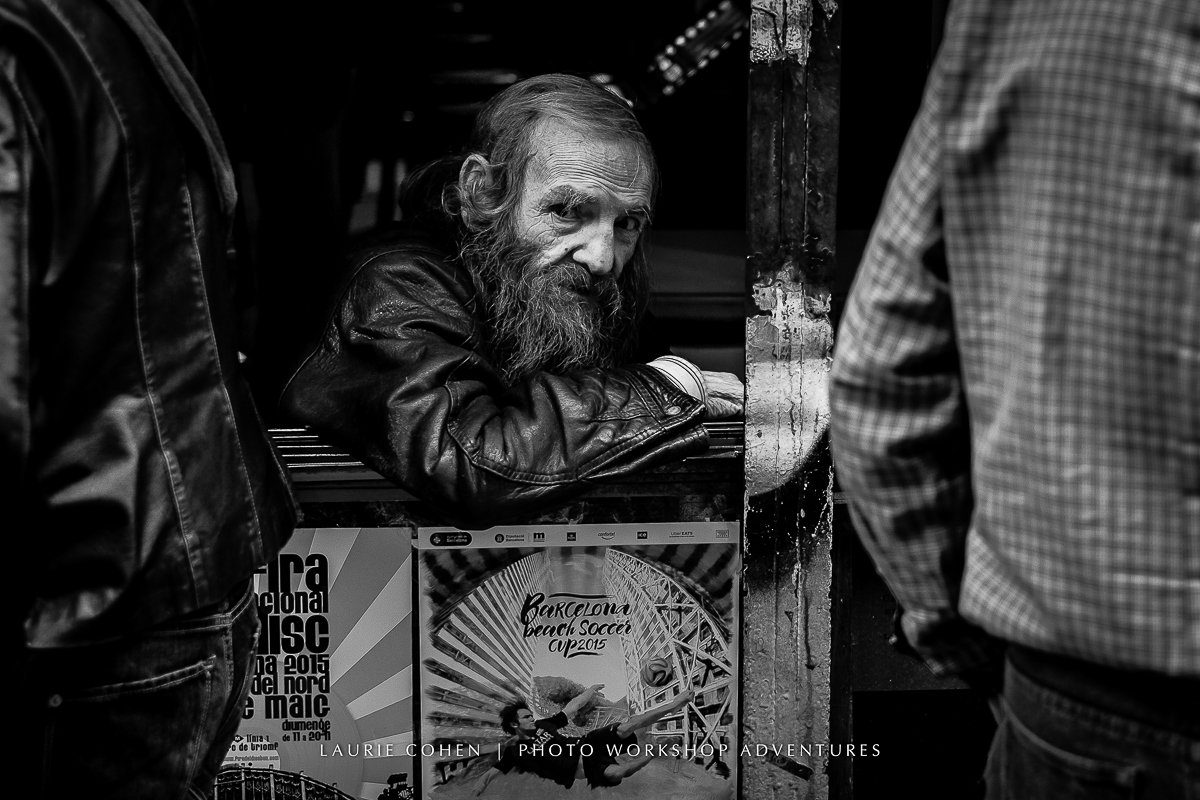
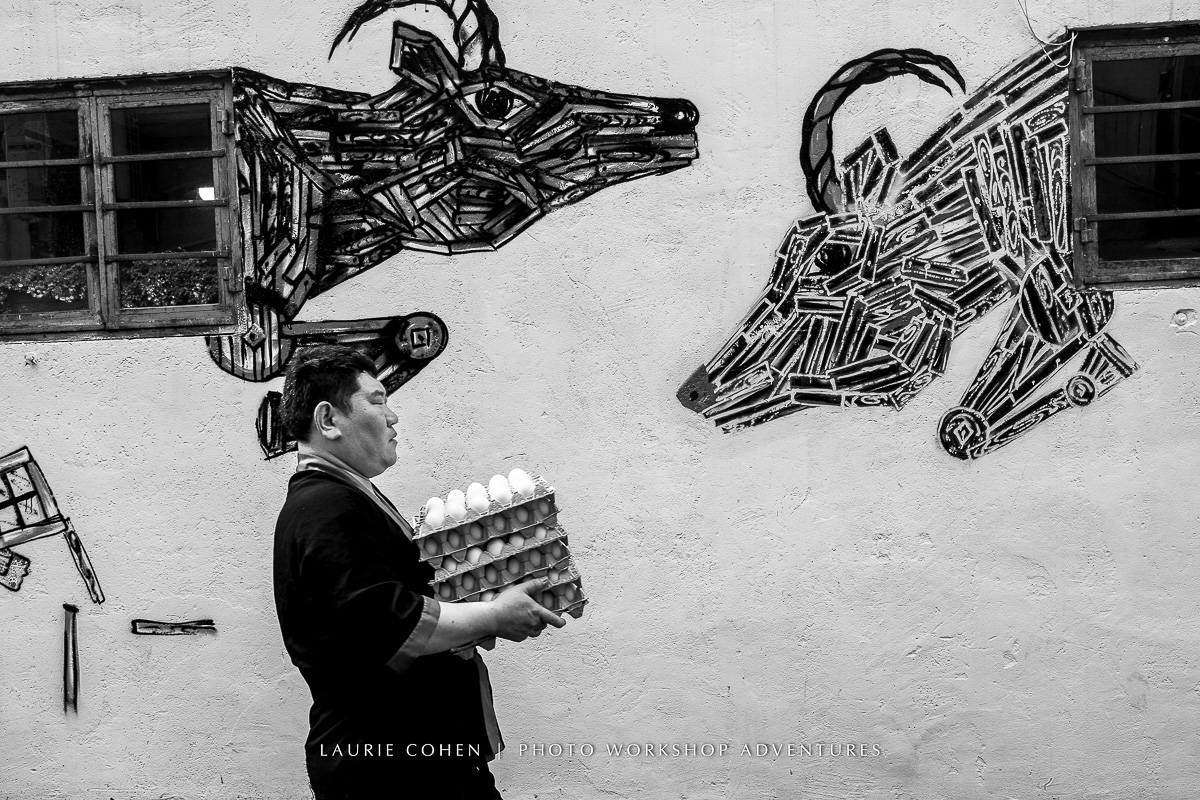

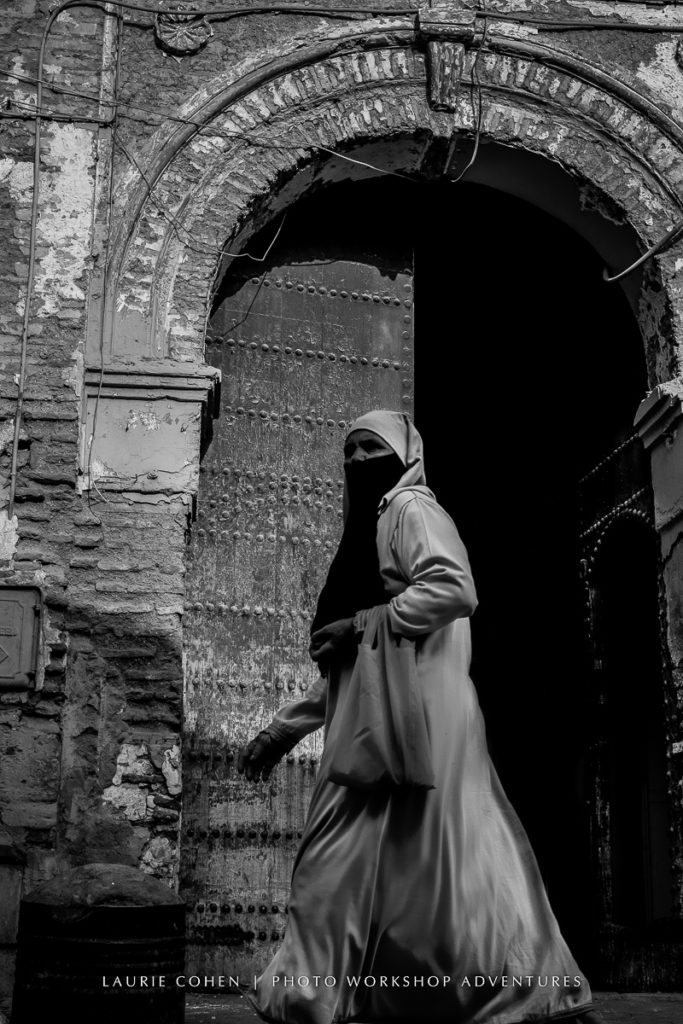
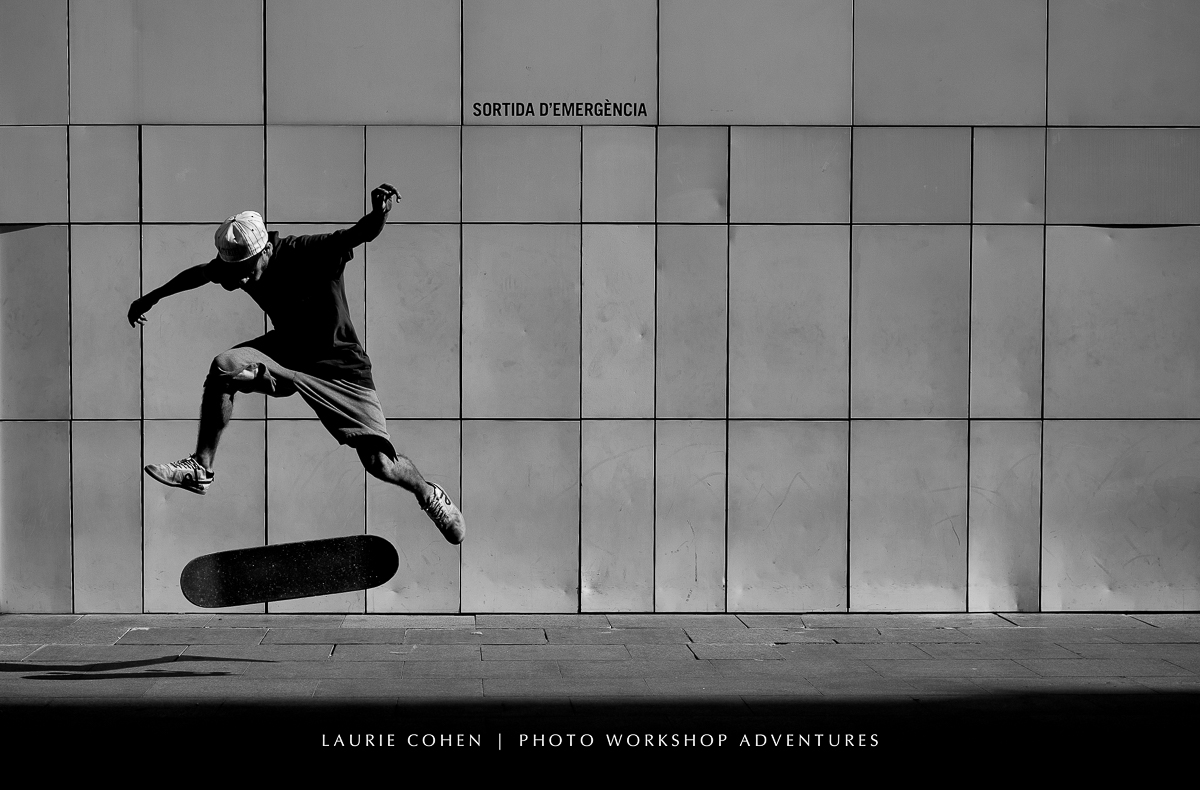
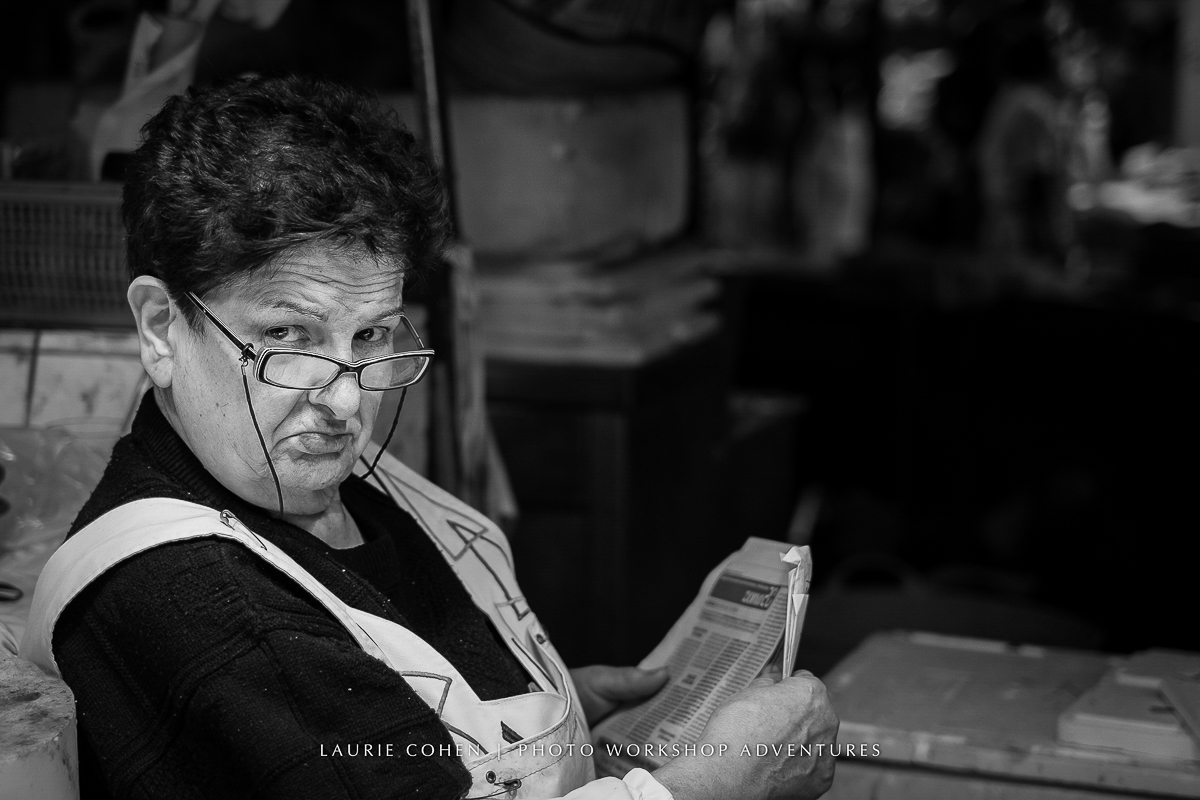
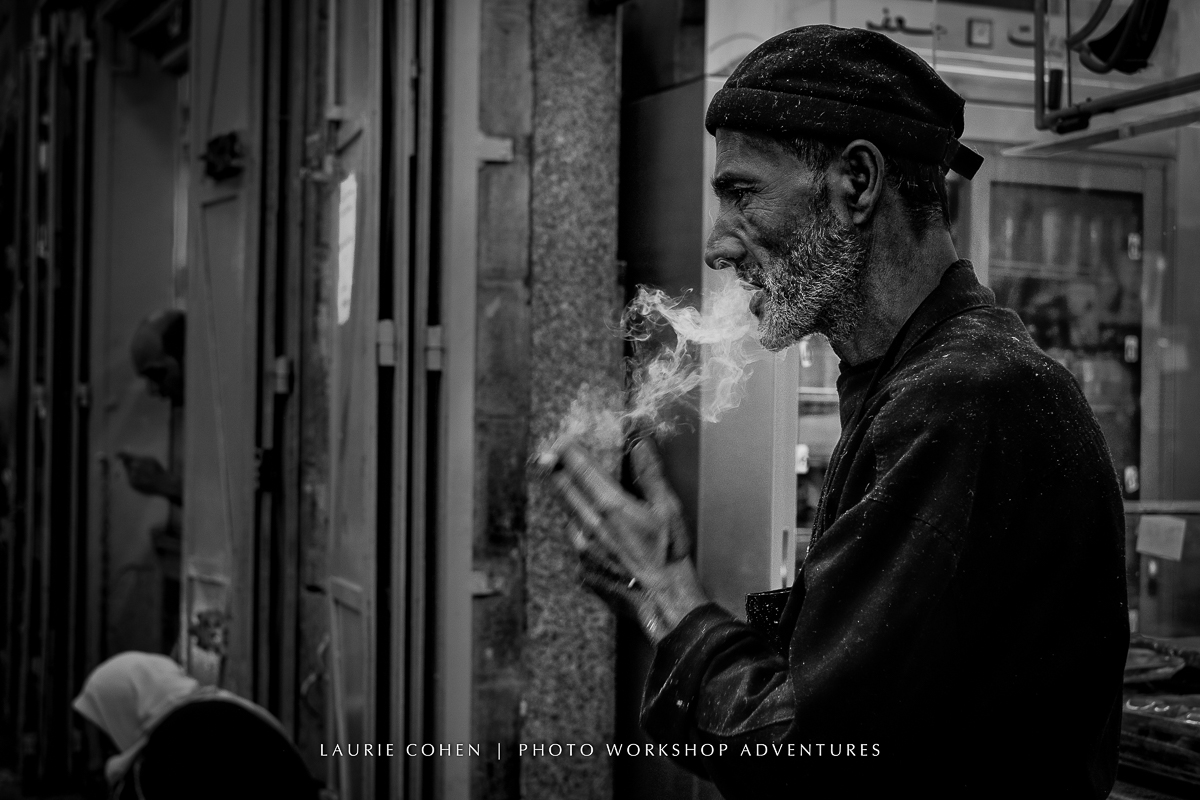

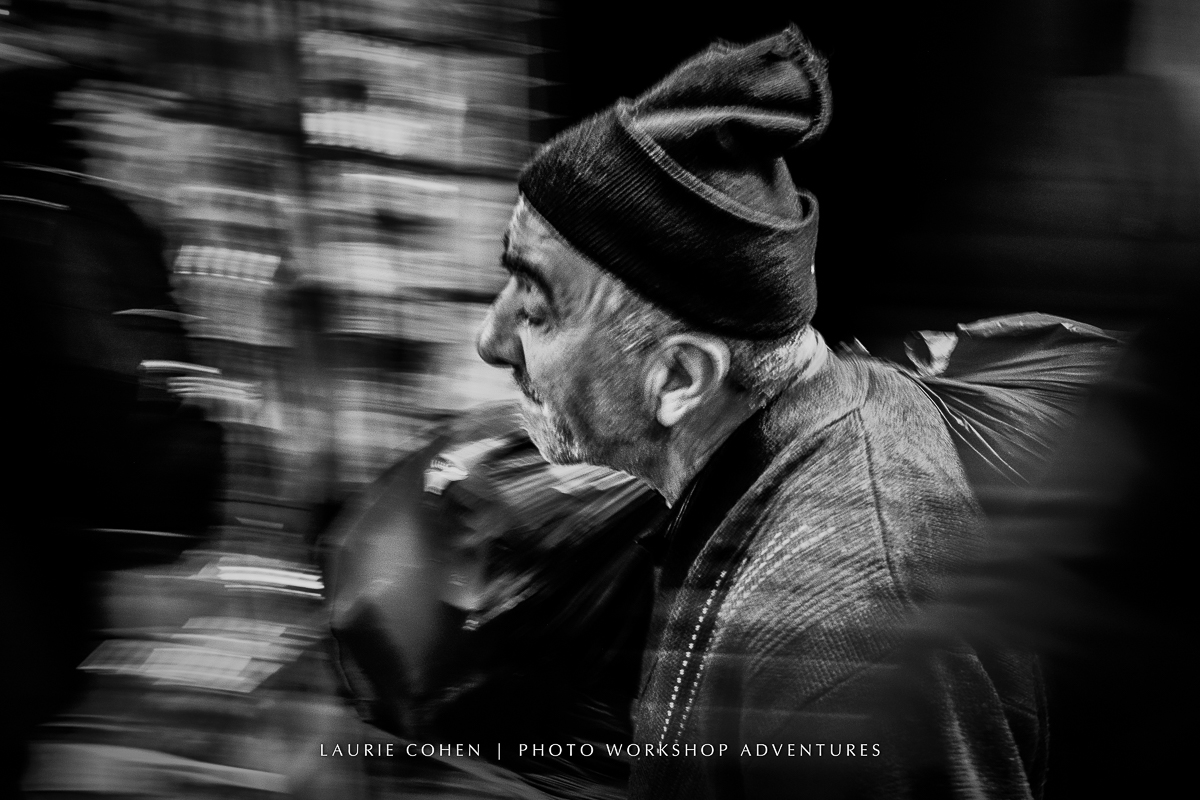
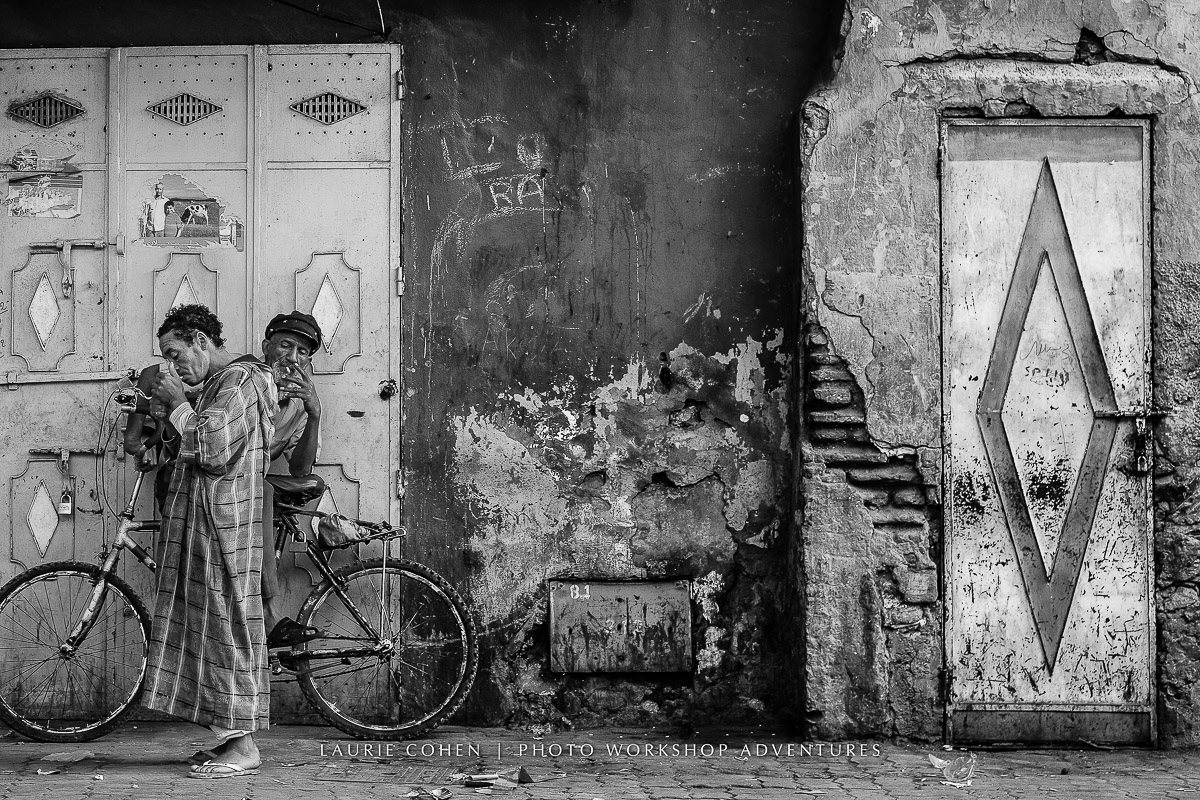
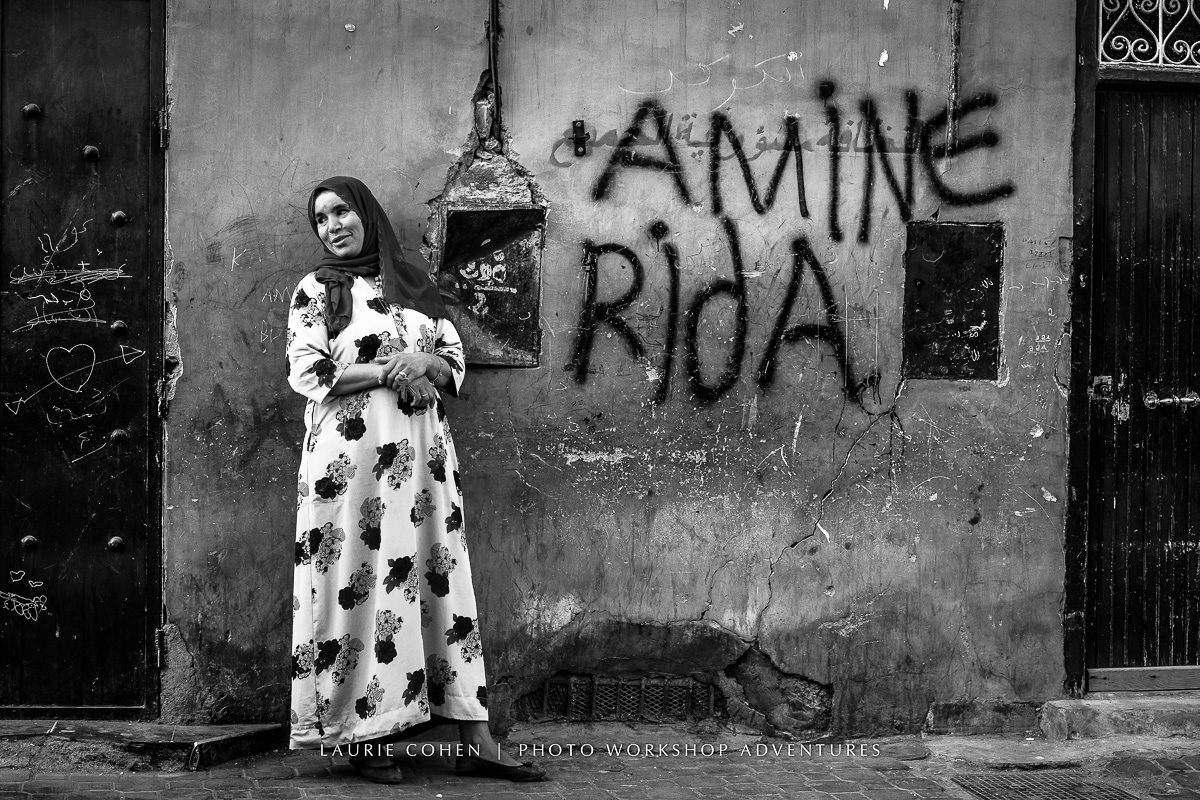
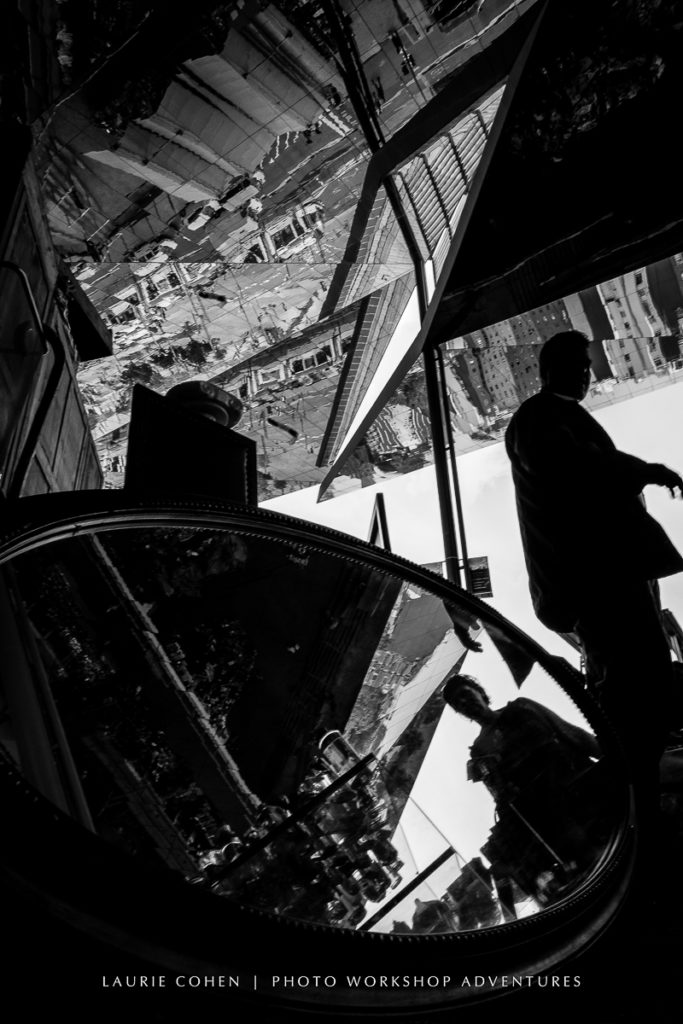
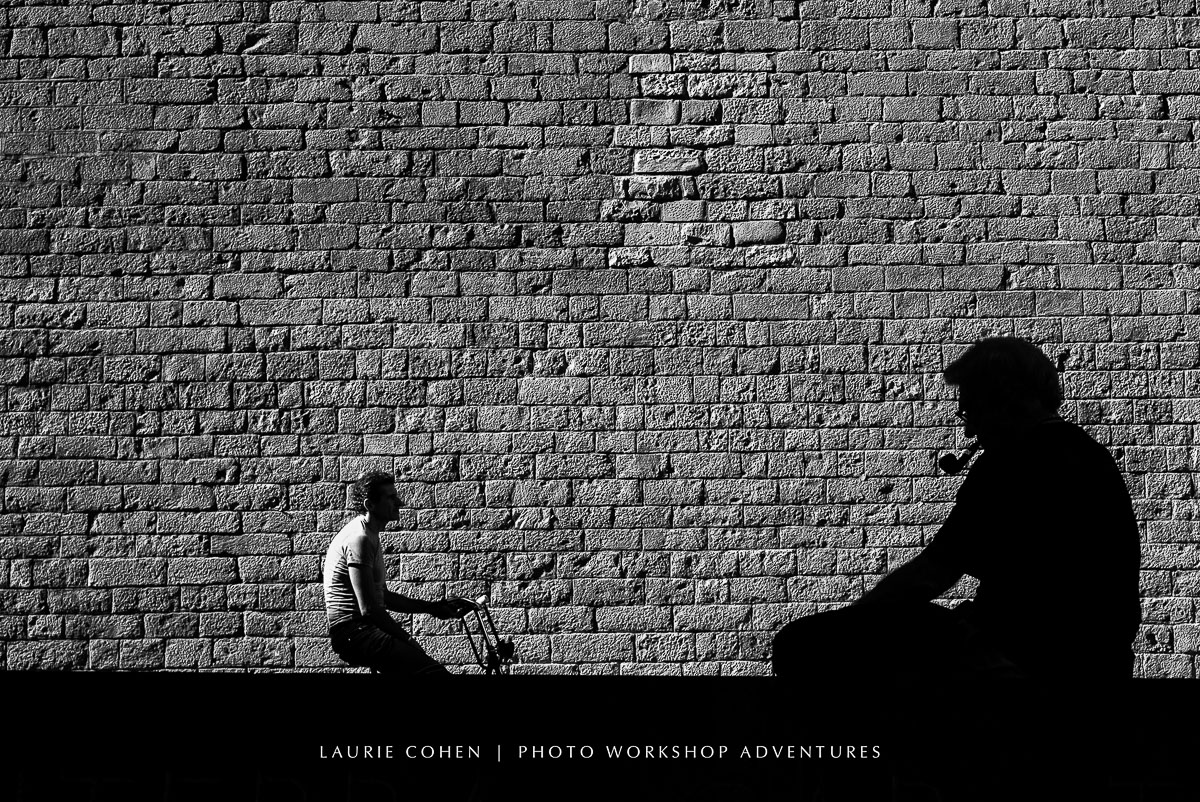
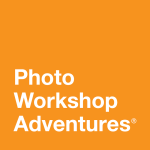






6 Comments